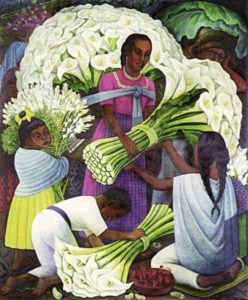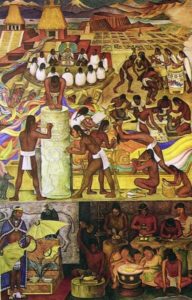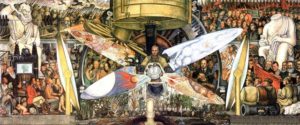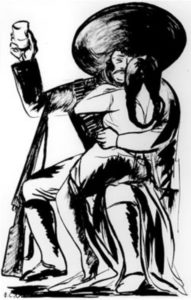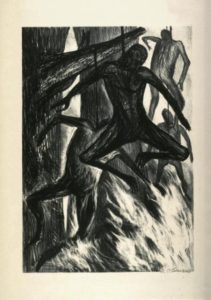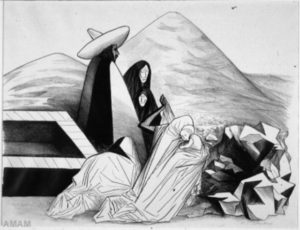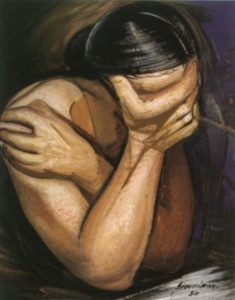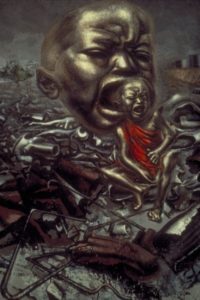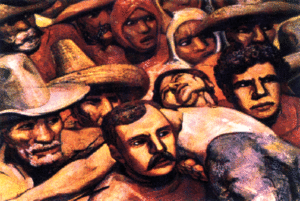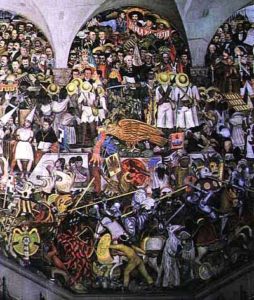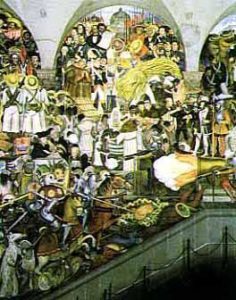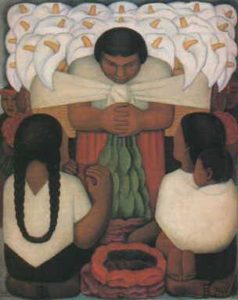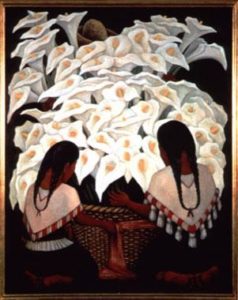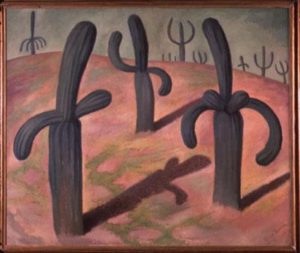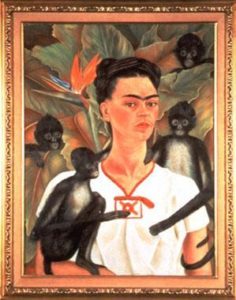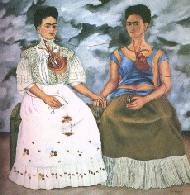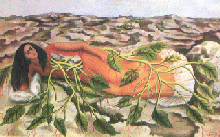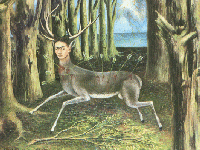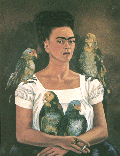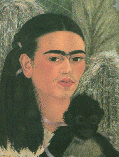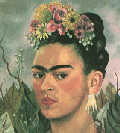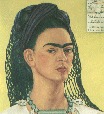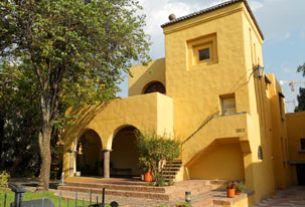In art as in life, Diego Rivera was a man constantly in rebellion. At 16, he left the prestigious San Carlos Academy in Mexico City in protest against the academy’s emphasis on representational art. He became an avid Marxist but outraged the Stalinist regime in the Soviet Union by welcoming Trotsky to Mexico. Rivera shocked religious believers by including the phrase “God does not exist!” in one of his murals. In 1948 a group of students burst into the Del Prado hotel, where the mural hung, to carve out “does not exist!” Nothing daunted, Rivera led a shock troop of a hundred left-wing artists and intellectuals into the hotel. Amid shouts of “Death to imperialism!,” the words were carved back in.
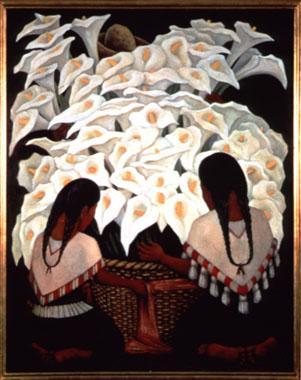
Rivera was born in Guanajuato, capital of the similarly named state, on December 8, 1886. In 1892 his family moved to Mexico City. While at the San Carlos Academy, before his protest and departure, such paintings of his as Paisaje de Mixcoac (“Mixcoac Landscape”) show the influence of José Velasco, Mexico’s great landscape painter.
Rivera had his first exhibition in 1907, which resulted in a scholarship that took him to Europe. After sojourns in Madrid and Paris, he went back to Mexico in the fall of 1910, In July of the following year he again left for Paris. There, between 1912 and 1917, he was affiliated with the cubist school, then considered the ultimate in avant-garde artistic expression.
Returning to Mexico in 1921, Rivera painted his first important mural in 1922. Titled Primera Energía, its theme is the primal energy that animates both Man and Woman, with all its powers and potentialities. Rivera also won high praise for frescoes, painted in 1927, for the Auditorium of the National Agricultural School at Chapingo. Some critics consider these to be his finest work. Also in this building is the mural “Biological Evolution and Social Evolution,” a philosophically symbolic synthesis in which the female nude figures are considered among the most impressive in modern art.
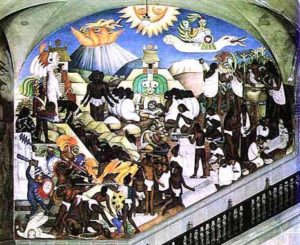
In Mexico’ s Palacio Nacional (“Presidential Palace”) are frescoes that express Rivera’s interpretation of Mexican history. The ones on the staircase cover the period up to 1935 and in the corridors from 1943 onward. These highlight the weltanschuaung of an artist who is also a committed ideologue. Rivera harks back to Mexico’s pre-Columbian past and particularly impressive — especially for its striking colors — is his depiction of the marketplace in the Aztec capital of Tenochtitlán.
Rivera the political man is of almost as much interest to us as Rivera the artist. The painter was a lifelong militant atheist and revolutionary Marxist. But events in the Soviet Union would create for him an intense ideological dilemma. When Stalin gained the upper hand in the struggle against Trotsky, he banished him from Soviet territory in February 1929. At the time, Rivera sided with Trotsky. Turkey granted Trotsky asylum and he remained there until 1933, when he moved to France. In 1935 Trotsky left France for Norway but Soviet pressure got him expelled from that country at the end of 1936. At Rivera’s behest, President Lázaro Cárdenas agreed to give Trotsky asylum. On January 9, 1937, his ship from Norway was greeted by the commander of Cárdenas’s presidential train. Trotsky and his entourage were greeted by Rivera at a small station near Mexico City and then transported to the Blue House, Rivera’s magnificent residence in Coyoacán. This would be Trotsky’s home for the next two years.
In February 1938 Rivera and another Trotsky admirer, the French Surrealist poet André Breton, signed a manifesto in Partisan Review, a left-wing anti-Stalinist New York literary magazine, calling for creation of an International Federation of Revolutionary Writers and Artists. Purpose of the federation was to resist Stalinist cultural domination in the arts.
Rivera’s contrarian nature caused a break between him and Trotsky in 1940. This was a presidential election year and Cárdenas’s choice to succeed him was Manuel Avila Camacho, a former general who was more conservative than Cárdenas and a religious believer to boot. Though Cárdenas had welcomed Trotsky to Mexico, there was a strong Stalinist element among his followers. This faction included labor leader Vicente Lombardo Toledano and another celebrated Mexican painter, David Alfaro Siqueiros.
The Stalinist ring around Cárdenas caused Rivera, much to Trotsky’s dismay, to attack Cárdenas as “an accomplice of the Stalinists.” Rivera also decided to support Avila Camacho’s opponent in the coming election, a general named Juan Andrew Almazán. Almazán was even more right-wing than his opponent, promising to bring the unions into line and enjoying the backing of Mexico’s neo-Nazi movement. Trotsky deplored Rivera’s support for Almazán as well as his denunciation of Cárdenas. Realizing how precarious was his position in Mexico, had no desire to needlessly antagonize the existing president. The break caused Trotsky to move out of Rivera’s house. At the same time, he was fair-minded enough to describe Rivera as “a genius whose political blunderings could cast no shadow either on his art or on his personal integrity.”
The most influential woman in Rivera’s life was Frida Kahlo, his lover and later his wife. A talented creative spirit in her own right, part-Jewish with a crippled leg and a stunningly beautiful face, Kahlo accompanied Rivera when he led the raiding party into the Del Prado to reaffirm the nonexistence of God. This merry band, which included such figures as José Clemente Orozco, David Alfaro Siqueiros, Gerardo Murillo (“Dr. Atl”) and Juan O’Gorman, was a virtual Who’s Who of Mexico’s intellectual leftist elite.
Unpredictable as ever, Rivera recanted his Trotskyism after Trotsky’s assassination and, in Isaac Deutscher’s words, “return(ed) contritely to the Stalinst fold.” He had been to the Soviet Union in 1927-28. He returned triumphantly in the mid-1950s and then organized an exhibition with a pro-Soviet theme.
Diego Rivera died in Mexico City two weeks before his seventy-second birthday. Date of his death is November 24, 1957.
Other Articles:

